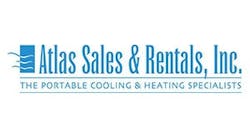Portable heat pumps look identical to spot coolers (portable air conditioners), but with the addition of a heating function that is safer and more efficient than resistive electric heating. Portable heat pumps are unique in their ability to provide versatile “two-in-one” cooling and heating functions – at an incremental cost of around 20-30% higher than a same-size unit with cooling only. Applications range from spot heating and cooling of spaces ranging from office environments to retail floors to schools to industrial processes.
The most common type of portable heat pump today uses air-cooled technology. A reverse-cycle refrigeration system directs cooled and dehumidified air or warmed air to a conditioned space. In the cooling mode, a direct-expansion device allows the refrigerant to evaporate and cool a heat exchanger which cools and dehumidifies an air stream flowing through the heat exchanger and then to the conditioned space. The heat absorbed from the air stream is rejected to the environment by means of another air stream flowing through a condensing heat exchanger. In the heating mode, the functions of the heat exchangers and air streams described above are reversed. Heat is absorbed from the environment and rejected into the conditioned space.
Heat pumps provide much more heat, about three times more, than electric resistance heat of the same kW consumption. And because they are constructed of all mechanical parts, they eliminate the fire hazards encountered with electric space heaters.
Probably the biggest drawback to portable heat pumps involves their operating temperature limitations. These units require minimum ambient temperatures ranging from about 45 – 55 degrees F to operate, so the climate must be temperate or another heating source must be available.
Portable heat pumps typically range from 1 to 5 tons (or up to about 60,000 BTU) in capacity, are mounted on wheels and are designed to fit through standard interior doors.
Also available are water-cooled portable heat pumps that use water instead of air to remove heat from the refrigerant inside. Water-cooled portables can perform in any temperature above freezing, offering greater operating range and greater capacity than same-sized air-cooled counterparts, as it is possible to pull heat out of water more readily than out of cold ambient air. They are an excellent choice in the right conditions, but they are limited to use in areas where the municipal water supply is plentiful or in buildings with closed-loop cooling towers.
Other options for portable heating are:
Direct fired heaters (also known as construction heaters) – Air is blown across a natural gas or propane flame and into the area to be heated. For temporary use in well-ventilated open areas, it is a viable choice and can help speed construction processes such as ground thawing, concrete and drywall curing, etc. These units typically feature very large capacities of 400,000 – 1,500,000 BTU.
Electric heaters, whether large or small, use resistive heat which is very effective in cold environments but is the most expensive form of heat you can get. Large electric heaters with capacities of 34,000 - 512,000 BTU are quite popular. They use a forced air fan to blow or duct fresh, warm air to the area to be heated, delivering clean, dry air with no emissions. Electric power may be an issue: These large heaters usually require 3-phase 220 V or 460 V high voltage wiring, which may not be available – sometimes necessitating the use of a generator or an electrician.
Much smaller electric space heaters are also used for spot heating, but due to the well-known safety issues (e.g., the potential for nearby drapes or furnishings to catch fire, or for office workers to singe a hand or foot on the exposed coils), these units are often prohibited for use in commercial buildings.
Indirect fired heaters are gaining in popularity due to the benefits of enhanced fire safety, no harmful emissions, and the ability to heat outdoor or indoor areas including construction sites, manufacturing/industrial areas and tents. These powerhouses generate a high amount of heat (ranging from about 100,000 – 1,000,000 BTU capacity) and are user-friendly.
Indirect fired heaters incorporate a heat exchanger with a natural gas line or propane or kerosene tank that heats up the air. Fresh air is heated and then blown or ducted into a building or other area, with no worries about open flames or toxic emissions as experienced with direct fired heaters.
For further information:


